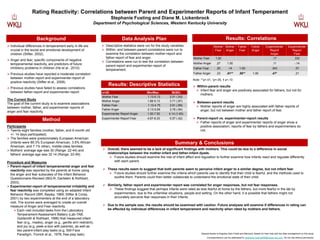
SFusting REACH Poster
- 1. Rating Reactivity: Correlations between Parent and Experimenter Reports of Infant Temperament Stephanie Fusting and Diane M. Lickenbrock Department of Psychological Sciences, Western Kentucky University Background Summary & Conclusions Method Participants Twenty-eight families (mother, father, and 6-month old +/- 14 days participated). The families were predominately European American (infants were 89.3% European American, 3.6% African American, and 7.1% other), middle-class families. Mothers’ average age was 30 (Range: 22-44) and fathers’ average age was 32.14 (Range: 22-49). Procedure and Measures Parent-report of infant temperamental anger and fear reactivity was reported by the parents at home using the anger and fear subscales of the Infant Behavior Questionnaire-Revised (IBQ-R; Gartstein & Rothbart, 2003). Experimenter-report of temperamental irritability and fear reactivity was completed using an adapted Infant Behavior Record (IBR; Bayley, 1969; Stifter & Corey, 2001) by two experimenters at the end of a laboratory visit. The scores were averaged to create an overall measure of Anger and Fear reactivity. Each visit included tasks from the Laboratory Temperament Assessment Battery (Lab-TAB, Goldsmith & Rothbart, 1996) that measured infant fear (e.g., masks), anger (e.g., gentle arm restraint), and joy (e.g, peek-a-boo with parents), as well as two parent-infant play tasks (e.g, Still-Face Paradigm, Tronick et al., 1978; free-play task). Results: Descriptive Statistics Individual differences in temperament early in life are crucial in the social and emotional development of children (Stifter, 2002). Anger and fear, specific components of negative temperamental reactivity, are predictors of future inhibitory problems in children (He et al., 2010). Previous studies have reported a moderate correlation between mother-report and experimenter-report of positive reactivity (Stifter et al., 2008). Previous studies have failed to assess correlations between father-report and experimenter-report. The Current Study The goal of the current study is to examine associations between mother, father, and experimenter reports of anger and fear reactivity. Overall, there seemed to be a lack of significant findings with mothers. This could be due to a difference in social relationships between the mother-infant and father-infant dyads. Future studies should examine the role of infant affect and regulation to further examine how infants react and regulate differently with each parent. These results seem to suggest that both parents seem to perceive infant anger to a similar degree, but not infant fear. Future studies should further examine the criteria which parents use to identify that their child is fearful, and the methods used to soothe them. Parents could then better collaborate to understand the emotional state of their child. Similarly, father report and experimenter report was correlated for anger responses, but not fear responses. These findings suggest that perhaps infants were rated as less fearful at home by the fathers, but more fearful in the lab by experimenters, due to the unfamiliar situations, people and setting. On the other hand, it is possible that fathers might not accurately perceive fear responses in their infants. Due to the sample size, the results should be examined with caution. Future analyses will examine if differences in rating can be affected by individual differences in infant temperament and reactivity when rated by mothers and fathers. n=28 Min/Max M(SD) Mother Fear 1.13-5.13 2.51 (.93) Mother Anger 1.88-5.13 3.71 (.87) Father Fear 1.13-4.75 2.61 (.89) Father Anger 2.13-5.69 3.78 (.94) Experimenter Report Anger 1.50-7.50 4.14 (1.65) Experimenter Report Fear 4.67-6.33 5.57 (.42) Results: Correlations Mother Fear Mother Anger Father Fear Father Anger Experimenter Report Anger Experimenter Report Fear Mother Fear 1.00 .17 .33† Mother Anger .27 1.00 .11 -.14 Father Fear .20 .14 1.00 .34† .07 Father Anger .23 .61** .50** 1.00 .47* .21 Note: **p<.01, *p<.05, † p<.10 Within-parent results Infant fear and anger are positively associated for fathers, but not for mothers. Between-parent results Mother reports of anger are highly associated with father reports of anger, but not between mother and father report of fear. Parent-report vs. experimenter-report results Father reports of anger and experimenter reports of anger show a positive association; reports of fear by fathers and experimenters do not. Data Analysis Plan Descriptive statistics were run for the study variables. Within- and between-parent correlations were run to examine the correlation between mother-report and father-report of fear and anger. Correlations were run to test the correlation between parent-report and experimenter-report of temperament. Special thanks to Angelica Soto-Freita and Manooch Saeedi for their help with the data management on this study. Correspondence can be addressed to stephanie.fusting868@topper.wku.edu. Do not cite without permission.